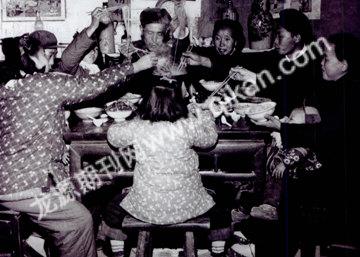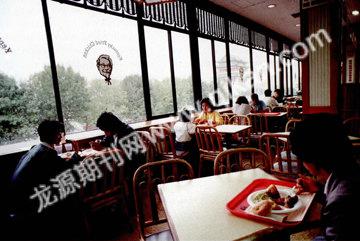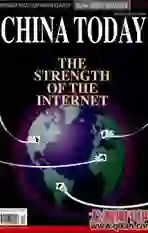Food in China:From Getting Enough to Eating Right
2009-05-05ByWUNA
By WU NA

WHEN the Peoples Republic of China was founded in 1949, the US Secretary of State Dean Acheson commented that Chinese dynasties had all come to grief over their failure to solve the food problem, and the Communist regime would be no different. According to John Leighton Stuart, before 1949, 3-7 million Chinese people died of hunger each year. Providing enough food for 550 million people was the key question faced by new China.
Food Coupons and “Substitute Food”
In 1953, China began to institute a state monopoly over the purchase and distribution of grain. This lasted 31 years, making food coupons a necessity in peoples daily lives. In addition, until the late 1970s, meat, eggs, milk and aquatic products were in short supply. Cai Yuanchao, aged 58, a food coupon collector, recalled that during this period grain and meat were rationed for every household, making food coupons the nations “lifeblood.” He clearly remembers eating coarse grain and water-boiled vegetables pickled with salt for almost every meal during his childhood. Per capita daily meat consumption was less than 50 grams. Therefore, people preferred fatty meat, since people could extract lard by boiling down the fat, which was then used to cook vegetables. The dregs of fat were considered a rare delicacy. In rural areas life was even harder. The staple food was steamed corn bread, vegetable porridge and pickles. Farmers seldom had stir-fried meat dishes. Even so, this was a great improvement over life before liberation, when average landlord families, let alone tenant farmers, could not afford to eat steamed wheat bread and meat dishes very often.
Even state leaders led frugal lives. Premier Zhou Enlais staple food was coarse grain, plus one meat dish, one vegetarian dish and soup. Famous writer Bing Xin and her husband were invited to have dinner with Premier Zhou, and stir-fried egg was the only “good dish.” Bing Xin recalled, “What surprised me was that the Premiers food was so simple.”
People longed for Spring Festival, because the family reunion dinner was the most sumptuous meal of the year. An article in the Beijing Daily newspaper recorded the reunion dinner of an ordinary family in 1957: “I bought several jin of pork, one chicken, and one fish, plus some vegetables and bean curd – enough for my family to eat happily for several days. In addition, we made two basins of jiaozi.”
Due to wrong policies and natural disasters, starting in 1959 China entered a three-year “difficult period.” Famine was seen in both urban and rural areas. Farmers in certain areas had to go begging for food, and in some localities people starved to death. A “substitute food” was launched, comprising ground stalks of tomato, eggplant and maize, and ground sweet potato vines. It could allay ones hunger, but was difficult to digest. One ballad described it thus: “When steamed breads of substitute food are served, people give precedence to one another modestly. Taking a look at it, it looks like horse dung. Biting it, it tastes strange. And after three mouthfuls, everyone vomits.”

Chinese peoples diets did not improve greatly until the 1970s. Zhao Zhanling, who went to the countryside to live and work as a “sent down youth,” recalled that in 1978, when he was a farmer in Shanxi Province, all three meals a day comprised mainly corn. Breakfast was steamed cake made from corn flour plus pickles, lunch was steamed corn bread plus boiled Chinese cabbage and potato strips, and occasionally a few pieces of bean curd, and supper was a big bowl of corn porridge, two pieces of steamed corn bread, and pickles. He always felt hungry by midnight.
Farewell to Coarse Grain and the Rise of
Health Products
In the 1980s, per capita annual grain production reached 400 kg, ending the history of grain shortages in China. China feeds 22 percent of the worlds population with seven percent of the worlds arable land.
But in the early 1980s food was still in short supply, and food coupons reached their zenith. Besides food and cooking oil coupons, there were coupons for pork, beef, mutton, chicken, duck, fish, eggs, sugar, bean curd products and all kinds of vegetables. Food grain coupons included those for rice, wheat flour, coarse grain, millet and potatoes. The many varieties of coupons were related to the diversification of available food.
Zhu Guangrong, who worked in Beijings foodstuff industry, recalls that at that time there were long queues in front of every food counter. Even frozen fish and expired candies were valuable supplies that people bought without complaint. So-called “high-grade candies and pastries” were ordinary fruit drops and walnut cookies, priced at RMB 10 per kilogram. The monthly salary for an ordinary wager-earner was RMB 40-50, but these hot items were in great demand.
On weekends or at the end of the month, food grain shops were the busiest places and long lines of customers would snake out of every door. Food grain stations were responsible for the neighborhood grain supply. According to regulations, inhabitants were only allowed to buy grain in their assigned shop. If they moved to another neighborhood, they had to transfer their “food relations.” When people went on business trips or visited other parts of the country, they were allowed to change a certain amount into “universal food coupons” by showing a certificate issued by their workplace, so they could buy food in other localities.
With economic reform in rural areas, Chinas grain output continually increased. In 1985 the state monopoly was relaxed and grain distribution reformed. As well as using food coupons to buy grain, people could purchase grain at a “negotiated price,” usually double the coupon rate. More and more food items could be purchased withoutcoupons, so people had more and more disposable coupons and could trade them for other commodities. For example, people could swap a 3-kg grain coupon for one kilogram of eggs, or a 20-kg universal food coupon for a small aluminum basin.
The difference between the low fixed prices and the “negotiated” prices placed a heavy burden on the government, while the non-transferable nature of most food coupons hindered the population flow. In 1993, the Chinese government abolished food coupons altogether, and lifted price controls over grain. From that time on, rural inhabitants began eating fine grain (usually wheat flour and rice) as their staple food.

In the mid-1980s China carried out the “Vegetable Basket” project, aiming to solve shortages of poultry, eggs, milk, fruits and vegetables. Through efforts over nearly a decade, supplies of non-staple foods were greatly improved. The market flourished in terms of both supply and demand, and prices were stable. By 1999, China became the worlds largest producer of meat, eggs and aquatic products, and the annual per capita consumption rate increased to five to 15 times that of the years before reform and opening-up. Coarse grain gradually disappeared from peoples dinning tables and fine grain became the main staple food. An unprecedented variety of vegetables and fruits became available. Chicken, duck, fish and meat, all of which used to appear on peoples dining tables only during festivals, became commonplace. Chinese peoples diet began to change from one of subsistence to one of comfort and choice.
One interesting phenomenon was the flourishing market for health products in the late 1980s. By 1994, the number of factories making these products had increased from less than 100 to 3,000, and more than 30,000 products were available. Annual output value increased from RMB 1.6 billion to RMB 30 billion. People paid greater attention to nutrition once the problem of providing enough food and clothing had been solved. Lured by the traditional concept of “medicines and food are from the same origin,” many consumers had blind faith in health products, and dealers exaggerated their benefits by blurring the differences between food and medicine. A selective survey on oral health liquids conducted by the Ministry of Health in the mid-1990s revealed that only 30 percent of the products were up to standard. Manufacturers lost the trust of consumers, resulting in the decline of the health products market.
With the promulgation of the Food Hygiene Law in 1995 and Measures for the Administration of Health Food in 1996, the government straightened out the health products market and established strict monitoring systems, putting the health products market on the right track. In 2004 the production value of health products amounted to RMB 50 billion. It is predicted that by 2010 Chinas health product market will have a capacity of RMB 100 billion.

Over Indulgence and Thinking Twice
In the 1990s Chinas per capita consumption of meat, aquatic products, poultry, eggs, fruit and vegetables all surpassed the world average, and the per head nutritional intake reached the level of a moderately developed nation.
Starting in the early 1990s, China saw a vogue of extravagant dining habits, and delicacies such as abalone, sea cucumber and sharks fins were sought after. Annual consumption on Chinese dining tables amounted to RMB 100 billion. A study of Chinese dietary trends shows that compared to other Asian nations, Chinese people place a greater emphasis on “face,” resulting in people pursuing extravagance in feasting, and prizing rare ingredients and wild game. In 2004, the deadly SARS (Severe Acute Respiratory Syndrome) outbreak, caused by eating a wild animal called masked palm civet, caused people to step back and think twice about this trend.

On November 12, 1987, the first KFC in China opened for business in Qianmen, one of Beijings busiest districts. It aroused debate on whether it was proper to open a foreign fast-food restaurant opposite Tiananmen Square. But a long line of customers in front of the shop was the publics direct answer. Within ten months it recouped its capital outlay and had the highest sales volume of any KFC outlet in the world. At that time, peoples average monthly salary was around RMB 100, making a set KFC meal of RMB 10 by no means cheap. Still, people went for the American fast food. For a period it was a vogue to hold birthday parties or weddings in KFC outlets, as it was regarded as being close to Western culture. In 1991, McDonalds opened its first mainland Chinese outlet in Shenzhen. By 2007, KFC had more than 2,000 branches on the Chinese mainland, and by the following year McDonalds had more than 1,000. American fast food restaurants have begun to open in county-level cities, and it is not uncommon to see farmers eating foreign fast food. Russian and French cuisine, Japanese cooking and Korean barbeque have also entered China. Some large supermarkets have set up special counters for imported foods.
This turning point in Chinese peoples dietary habits has seen a rapid increase in the intake of meat and fat, and a decrease in the intake of fruit and vegetables. According to three national surveys on nutrition, conducted respectively in 1982, 1992 and 2002, Chinas per capita meat consumption increased 10-fold from 1961 to 2000. However, modern lifestyles are gradually seeing the intensity of peoples physical activity decreasing, and chronic diseases linked to sedentary lifestyles in developed countries are also becoming prevalent among Chinas urban inhabitants, and are spreading to rural areas.
On the positive side, Chinese peoples intake of salt is decreasing, partly because people eat less pickled vegetables. However, the present intake of salt is still double the 6 grams per day suggested by the World Health Organization. Many local governments have distributed salt measuring spoons free of charge in an attempt to discourage high salt consumption.
In the 21st century, Chinese peoples diets are rich and colorful, and many have the desire to try new things. Various local cuisines go in and out of fashion across the country, but Sichuan cuisine, known for its hot flavor, is a perennial favorite. Popular dishes include Hot and Spicy Lobster, Sauteed Crab in Hot Spicy Sauce, and Hot and Spicy Fish Stew.
Especially since the SARS outbreak, people have shifted from a focus on whats “good to eat” to “eating properly.” Foods made from coarse grains have come back to dining tables because they are rich in vegetable fiber and trace elements, and milk has become a daily necessity rather than a luxury item.
Milk is considered by Chinese to be a food of magic functions. It is reported that the average height of Japanese youngsters is greater than that of Chinese youths because the former consume more milk. In the early 1990s, the average annual consumption of milk among Chinese youngsters was 2-3 kg per capita. In 2003, President Hu Jintao linked the consumption of milk to the enhancement of the Chinese nations physical quality. In 2006, Premier Wen Jiabao said, “I have a dream: that every Chinese person, especially children, can drink one pound of milk per day.” At present, many families have replaced soybean milk with cows milk for breakfast. The annual per capita consumption of milk products in urban areas increased from 9.23 kg in 1992 to 24.87 kg in 2007, and in rural areas from 1.16 kg to 3.52 kg.
In 2001, the Ministry of Agriculture started the Action Plan for Pollution-free Food, and in 2004 the state promulgated Measures for Organic Product Certification and Administration. But due to high prices, organic foods initially had few buyers, and lackluster demand meant organic foods were the most over-stocked commodities in supermarkets. After food safety issues began catching peoples attention, organic foods, especially vegetables and fruits, gradually became more popular, and people have begun to spend more money to “buy food safety.” In April 2008, public opinion on the Draft of the Food Safety Law was solicited. Du Huizhen, president of the Society of Nutrition of Shandong Province, remarked, “It is a qualitative leap from the Food Hygiene Law to the Food Safety Law.”
